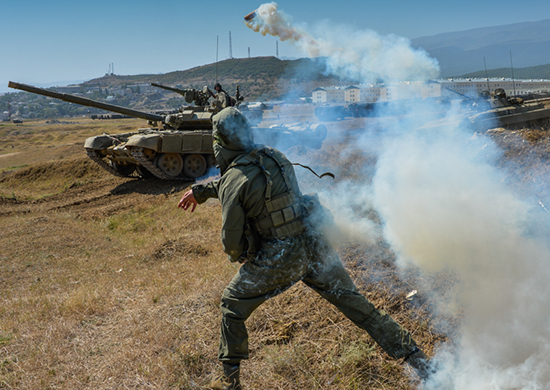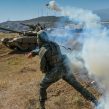
Novel Developments in Russia’s Latest Snap Exercise
Publication: Eurasia Daily Monitor Volume: 13 Issue: 148
By:

Since 2013, when no-notice “snap” exercises were first introduced, they have become a regular feature in the training of the Russian Armed Forces. These more-or-less comprehensive exercises—regardless of the number of troops and equipment involved—generally tend to follow the same pattern: participating units are alerted, redeployed and, thereafter, carry out some kind of combat activity, often involving live firing.
However, over time, the snap exercises increasingly became linked to large-scale Russian exercises recurring on a yearly basis, like Zapad, Tsentr, Vostok and the like. Indeed, Vostok 2014 and Tsentr 2015 were each preceded by a snap exercise; and the same was true prior to Kavkaz 2016. In 2014, the snap exercise ended on September 18 and was immediately followed by Vostok 2014, which officially began on September 19 (RIA Novosti, September 18, 2014; Mil.ru, accessed September 14, 2016). In 2015, however, Tsentr 2015 began on September 14, after a pause following a snap exercise that ended on September 12. That pattern was repeated this year: a snap exercise took place on August 25–31, and, after a brief five-day break, was followed by Kavkaz 2016 (September 5–10) (RIA Novosti, Mil.ru, accessed September 14; Mil.ru, September 7, 2015; August 25, 2016). It is also worth noting that over the last two years, the snap exercises were themselves preceded by command post and logistic exercises (Newsvl.ru, September 8, 2014; Arms-expo.ru, August 24, 2015; Mil.ru, August 11, 2016). Thus all the necessary preparations, rehearsals, and so on are accomplished prior to the main exercise, which can then be carried out without any major setbacks. It therefore seems reasonable to assume that the pattern established in 2015 and 2016 will become a standing procedure in connection with forthcoming yearly exercises.
The snap exercises prior to the yearly exercises have also developed when it comes to their content. This year, the authorities clearly stated that the snap exercise was, in fact, part of the preparations for Kavkaz 2016, an admission that had not been made previously. Two other novel, never-before-observed features of the late-August snap exercise also stand out. First, the Russian Armed Forces “together with federal executive authorities [and the] executive authorities of the subjects of the Russian Federation” were explicitly tasked to “work out questions concerning interdepartmental planning, organization of cooperation, and the practical fulfillment of the industrial enterprises’ mobilization tasks.” Second, Deputy Defense Minister Tatanja Sjevtsova was charged with “organizing the control of the transition from peace to wartime of the system of financial provision of staffs and units in the southwestern strategic direction” (Mil.ru, August 25).
Not much has been mentioned about the domestic industry’s role during the exercise. But it seems to have focused on the indigenous ability to equip the Armed Forces and to repair damaged or faulty military equipment (Mil.ru, Eurasian-defence.ru, August 30).
Meanwhile, the reason why the financial provision of participating units was part of the exercise is most probably explained by the fact that Russian military personnel are provided with credit cards rather than cash. But this payment system would likely not function properly during wartime (Gazeta.ru, August 31; Kolokolrussia.ru, August 29). To handle the payment of salaries and unexpected expenses during the course of the exercise, Bank of Russia organized five offices in the field; in addition, paymaster units manned with reserve officers were set up. Interestingly this segment of the exercise was subjected to a “hybrid warfare” scenario, whereby “diversionary groups” disabled the defense ministry’s financial functions. This simulated problem was reportedly solved by using the backup database in the national command center (Mil.ru, September 1).
During the snap exercise, reservists were also mobilized. And for the first time, the mobilization system was tested with contracted reservists. This was a direct result of a presidential ukase (edict) from July 2015, ordering the formation of units manned by contracted reservists—though experiments to carry this out began as early as 2013 (see EDM, June 27; Kremlin.ru, July 17, 2015; Rg.ru, October 30, 2013). The total number of reservists mobilized last August is unclear. Ukrainian sources mention 4,700 men called up in Stavropol krai alone (Joinfo.ua, August 26). However, the Russian Ministry of Defense mentions only 4,000 reservists and the mobilization of one mechanized battalion, two companies and one reconnaissance platoon in the Northern Fleet and the Central and Southern Military Districts, as well as an additional 700 reservists for territorial defense (Mil.ru, September 6). The units manned by contracted reservists are assumed to have augmented the standing units, among them the 205th Mechanized Brigade in Budyonnovsk. Although some sources claim that they were part of the territorial defense (Gubernator.stavkray.ru, News-front.info, August 29).
Although the actual number of troops in the August snap exercise is not known with any certainty, according to Krasnaya Zvezda about 4,000 regular soldiers took part (Krasnaya Zvezda, September 1). This seems quite low, particularly considering that 120,000 individuals were involved in Kavkaz 2016 alone, according to Russian Chief of the General Staff Valery Gerasimov. General Gerasimov further mentioned that they originated from all military districts and various federal agencies; of that total, nearly 12,500 came from the Southern Military District (Mil.ru, September 9). Considering the multitude of exercises that took place in late August and early September 2016, the high figure of 120,000 participants strongly suggests that both the August 25–31 snap exercise and Kavkaz 2016 were only individual elements of a much broader common scenario—like Zapad 2013.
The fact that several new elements surfaced during the August snap exercise signifies that Russia is progressively building up its military capability in terms of forces, force structure as well as equipment. Yet, the exercise also showed that Russia’s Armed Forces are still working on developing an effective system for mobilization. Taken together, this implies that Russia does not yet have the ability to wage war beyond conflicts limited in space and time.




